PinotFile: 9.44 July 28, 2014
|
Anderson Valley: Newfound Perception of QualitySince I first wrote at length about Anderson Valley Pinot Noir in 2007, the perception of quality has changed dramatically. Back then, Anderson Valley grapes were frequently sold to wineries outside the Anderson Valley AVA and the prices demanded for Pinot Noir grapes were among the lowest in California. Today, winemakers outside the Anderson Valley are still clamoring for grapes, but there has been an infusion of talented young winemakers (Phil Baxter, Jr., of Baxter Winery, Jason Drew of Drew Wines, Anthony Filiberti of Knez Winery, and Joseph Webb of Foursight Wines, for example), new wineries, new ownership of prominent vineyards (Ferrington, Savoy, Cerise, Klindt, Londer and Demuth), and a serious commitment by Kendall-Jackson Estates to Anderson Valley (Champ de Rêves, La Crema, Maggy Hawk and Wind Racer), resulting in more progressive ultra premium producers rooted firmly in Anderson Valley, bringing with them a new found perception of quality to the region. The name ‘Anderson Valley’ on a label really has cachet today. Matt Kramer wrote in New California Wine in 2004, “Anderson Valley is one of California’s most desirable Pinot Noir locales. The results, however, are not yet in, so this remains (optimistic) speculation.” I think he would agree that today, Anderson Valley Pinot Noir stands with the best California has to offer, and there is no longer any need to speculate. In 2007, I provided summaries for the 26 wineries based in the Anderson Valley. Since then, there has been a remarkable transformation, with several wineries departing including Christine Woods Winery, Claudia Springs, Demuth Winery, Esterlina Vineyards & Winery (moved to Dry Creek), Gryphon Wines, Jim Ball Vineyards, Lazy Creek Vineyards (new owners), Londer Vineyards, Standish Wine Co., and Raye’s Hill Vineyard & Winery, and many new faces joining the region including Angel Camp Vineyards, Ardzrooni Family Wines, Balo Vineyards, Bink Wines, Champ De Rêves, Domaine Anderson, Foursight Wines, Knez Winery, Lichen Estate, Nelson Hill Winery, Panthea Wine, Roma’s Vineyard, Seebass Family Wines, Signal Ridge, and Witching Stick, bringing the total to 36 wineries based in Anderson Valley (Drew and Baxter are technically in the Mendocino Ridge AVA). More wineries than ever are sourcing Anderson Valley grapes, some exclusively and several predominantly, from Anderson Valley. Some are relatively new, but most are established names including Anthill Farms, Arista, Baliwick, Bravium (Mendocino Ridge), Briceland Vineyards, Bruliam, Cabot, Cakebread Cellars, Chename Wines, Copain Wines, Coulour Wines, CrossBarn by Paul Hobbs, E16, Dutton-Goldfield, Expression Vineyards, Frati Horn Wines, Fulcrum, Gros Ventre, La Crema, LIOCO Wines, Littorai, Lula Cellars, MacPhail Family Wines, Maggie Hawk Vineyard, Radio-Coteau, Rhys Vineyards, Texture, The Donum Estate, Twomey Cellars, Waits-Mast Cellars, Walt Wines, Williams Selyem, Wind Racer, Woodenhead, and Yorkville Cellars. What makes Anderson Valley Pinot Noir special? Within stylistic differences, two constants are readily apparent. The wines can have lower alcohols than their counterparts from warmer growing areas within California, and the wines have a crispness and brightness due to good tug of acidity. Because of the cool climate, Pinot Noir grapes are able to slowly ripen, achieving full phenolic ripeness without high sugars, while still retaining bright acidity. Some have likened the Pinot Noirs to those from the Willamette Valley, and even anointed Anderson Valley, “Baja Oregon.” Although the visible infrastructure in Anderson Valley never seems to change, and for many that is its charm, the winegrowing business is vibrant, evolving and prosperous, and the wines are among the most treasured in California not only by the pinotphile cognoscenti but the general consumer as well.
17th Annual Anderson Valley Pinot Noir Festival May 15-18, 2014 Anderson Valley, California
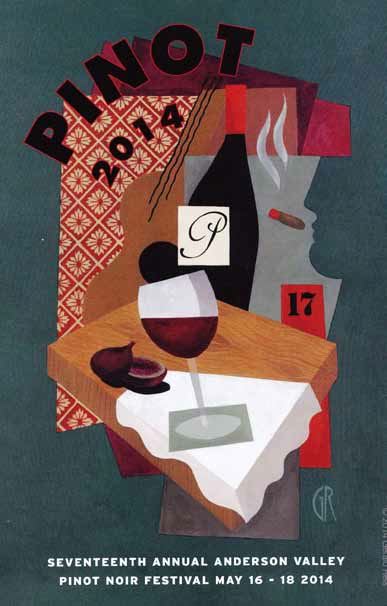 I am always glad when the Pinot Trail leads me to the annual Anderson Valley Pinot Noir Festival. I am attracted by the convivial winegrower hosts and organizers, the informal, country fair atmosphere, the delectable local artisan foods, and the superb, world-class Anderson Valley Pinot Noirs. When I leave Highway 101 at Cloverdale and begin the leisurely drive on winding, pastoral Highway 118 toward Anderson Valley, I leave my cares behind, and look forward to visiting a rather peaceful, reclusive Valley dotted with picturesque vineyards, moss-covered oaks, old apple-drying barns, split-rail redwood fences, and welcoming wineries.
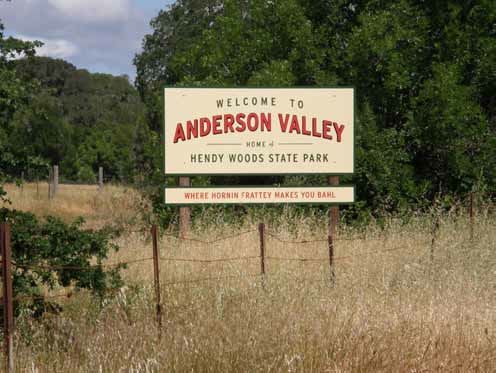 This year’s Festival marked the 50th (or 51st depending on who you ask) anniversary of the planting of wine grapes in the Anderson Valley in 1964 by Dr. Donald Edmeades, a cardiologist from Pasadena, California. In 1963, he bought 108 acres of grazing and orchard land north of Philo and began planting 24 acres of grapes excluding Pinot Noir. (Note: the Edmeades website reports that the first plantings were in 1963, but other sources date the plantings to 1964) The locals were skeptical and Edmeades, in good humor, put up a sign on Highway 128 that read, ‘Edmeades Folly.’ In truth, Edmeades had carefully researched the potential for wine grape growing in the Anderson Valley and had been visiting the region on vacations since the 1950s. The University of California at Davis viticulturists had completed a survey of the climate of the Anderson Valley, and classified it primarily as Region I (up to 2,500 degree days), ideal for cool climate grapes. Edmeades was the not the first to successfully grow wine grapes in the Anderson Valley. According to the book, Images of America Anderson Valley, wine grapes were a valley crop since the late 1800s when Italian immigrants from San Francisco settled in Greenwood located on the ridges of Anderson Valley (what is now known as Mendocino Ridge). The Valenti Ranch Vineyard is believed to be the first in Greenwood. Prohibition and frosts ended the early wine era in the valley with only the Zeni, Ciapusci and Dupratt vineyards surviving. Joe Pinoli was the first to established grapevines on the valley floor in 1911-1912, and he founded the first bonded winery in the valley. Edmeades grew French Colombard, Chardonnay, Gewürztraminer and Cabernet Sauvignon, and the grapes, which struggled to ripen, were sold to many buyers including Parducci. In 1972, the Edmeades winery and label was launched, but both Donald and his spouse passed away from cancer just after the winery was built, and a son, Deron, carried on. Edmeades achieved the most notoriety with Zinfandel produce from grapes sourced from vineyards in the Mendocino Ridge, but was never a major player in the Anderson Valley with Pinot Noir. The winery averaged ten Gold Medals a year in major competitions from 1994 to 2004, primarily for Zinfandel. The exact history of Pinot Noir planting at Edmeades is unknown although John Haeger dates it probably to 1980. The Edmeades property was acquired by Kendall-Jackson Estates in 1988, and Jesse Jackson modernized the winery and replanted vineyards. The Edmeades property is also now the home of Champ de Rêves, a winery dedicated to Pinot Noir from Anderson Valley’s Boone Ridge Vineyard, also owned by Jackson Family Estates. The two wineries recently opened for tasting daily from 10:00 to 5:00 at 500 Highway 128 in Philo. The first Pinot Noir planted in Anderson Valley was by Wilton (Tony) Husch at Husch Vineyards in 1967. He had acquired the 60-acre Nunn Ranch halfway between Philo and Navarro and planted a 3-acre parcel known as the Knoll block. In 1971, the first crop was harvested, and the same year, the back room of the Nunn Ranch house, built in 1920, became the first modern winery in the valley. The Festival kicked off on Friday with a Technical Conference held at the Mendocino County Fairgrounds followed by a casual BBQ at Foursight Wines that evening. On Saturday, a Press Tasting of Anderson Valley Pinot Noirs was held at Balo Winery, followed by the Grand Tasting in a tent at Goldeneye Winery. Sunday was devoted to Winery Open Houses. Reportedly, 1,300 people including consumers, trade and media attended the event.
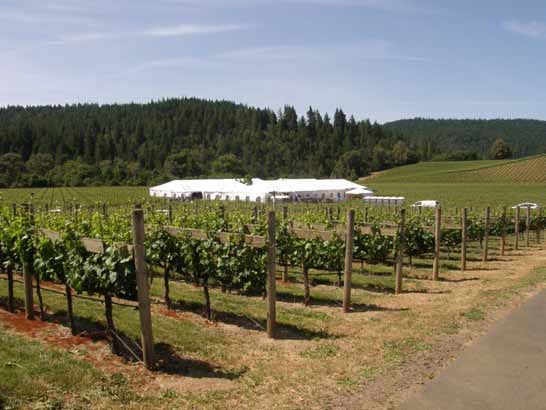 In the following pages I will report on the following: the Technical Conference, the Press Tasting, and my visits and tastings with the winemakers at Balo Vineyards, Drew Family Cellars, Knez Winery, Bink Wines and Signal Ridge Vineyard.
Highlights of the Anderson Valley Pinot Noir Festival Technical Conference
The Multiple Personalities of Anderson Valley Pinot NoirPanelists Arnaud Weyrich, Winemaker, Roederer Alex Crangle, Assistant Winemaker, Balo Vineyards Jim Klein, Winemaker, Navarro Anthony Filiberti, Winemaker, Knez Winery Michael Fay, Winemaker, Goldeneye
2013 Roederer Anderson Valley Sparkling Wine Harvest Brix 19º, pH 3.14, TA 0.90. Early pressing fraction. Picked at high acid showing intense citrus and acid-driven minerality. 5 tons per acre. Minimal skin contact, bladder pressed. Acid profile with essentially no astringency. 2013 Balo Anderson Valley Pinot Noir Blanc Harvest Brix 21.7º, pH 3.13, TA 0.70 - close to sparkling base. Clones “828” and 777. 3.3 tons per acre. 100% whole cluster, barreled in 75% stainless and 25% oak. No malolactic fermentation. Finished alcohol 13.6%, pH 3.23, TA 0.79. More body, fruit flavor than sparkling wine. Very crisp with berry, lemongrass and peach flavors. 2013 Navarro Anderson Valley Rosé of Pinot Noir Despite the high prices for Pinot Noir grapes and vineyard land, it is still possible from a cost standpoint to produce rosé in Anderson Valley. The majority of this wine is from Navarro’s Hammer Olsen block in Philo with about 10% from Navarro’s Boonville vineyards. Since Philo is closer to the Pacific Ocean, its a little cooler and produces wines with rose petal aromas and strawberry flavors. Boonville produces fruit flavors more reminiscent of raspberries. Harvest Brix 23.8º, pH 3.25. Chalone selection Pinot Noir with 7.5% Chardonnay contributing a peach component. Yield 4 to 4.5 tons per acre. Cold soaked 3 hours, then pressed. Fermented in stainless steel for three days, then sent to older barrels and aged sur lie. Finished alcohol 13.6%, pH 3.23, TA 0.79. Aromas and flavors of strawberry, cranberry and peach with bright acidity. 2011 Knez Cerise Vineyard Anderson Valley Pinot Noir Cerise is an 18-year-old vineyard spread out over 4 ridges and includes 13 blocks. Fruit from this vineyard can be a challenge to vinify as it can be powerful with aggressive tannins and an herbal and tobacco flavor element. Winemaker Anthony Filiberti is trying to craft more elegant wines without sacrificing mid palate intensity (power without weight). This wine has the scent of whole cluster with notes of cherry, spice and floral elements. Sappy, yet elegant with an intense attack, modest tannins, and a cherry-driven finish.
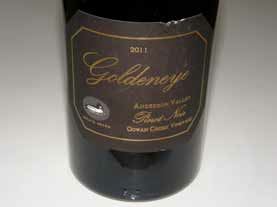 2011 Goldeneye Gowan Creek Vineyard Anderson Valley Pinot Noir Harvest Brix 25.0º. Aged 16 months in 60% new French oak and 14 months in bottle. Finished alcohol 14.6%, pH 3.80, TA 0.50. Vineyard is located centrally in the Anderson Valley at about 300 feet above the Navarro River, and containing considerable river rock. The vineyard is divided into 10 blocks and 8 clones. Primarily clone 777 with some Pommard and Mt Eden. A full-bodied wine with a velvety texture and a good tug of oak. Purple fruits are featured with a note of pennyroyal. Lush from this cool vintage but not jammy. (See my full review later in this issue.
The American herb, (mock) pennyroyal, or Hedeoma pulegiodes, is a species of mint also known as squaw mint, mosquito plant and pudding grass. It is an annual with small lilac-blue flowers that has a strong aroma similar to spearmint that is said to repel insects, especially fleas. The Greeks and Romans used pennyroyal as a cooking herb and the Greeks used it to flavor their wine. Pennyroyal oil is poisonous, but people have used the dried herb for centuries for medicinal purposes, Pennyroyal grows wild in the Anderson Valley and many producers including Black Kite, Goldeneye, MacPhail and Woodenhead have noted that the aromas of some of their Anderson Valley Pinot Noirs feature pennyroyal. You can impress your friends by throwing out, “I smell pennyroyal in this wine,” when tasting an Anderson Valley Pinot Noir.
Focus Tasting of Vineyard Designate Wines: Angel Camp VineyardPanelists Brian Zalaznik, Proprietor, Angel Camp Vineyard Anne Moller-Racke, President and Winegrower, The Donum Estate Dan Goldfield, Partner and Winemaker, Dutton-Goldfield Tony Sanchez, Ardzrooni Vineyard Management
Zalanik lost his older brother, his brother’s wife and their three sons in a tragic airplane crash in 2004. Afterwards, he looked for something that offered renewal in his life. Coincidentally, he was completing an internship at a winery and heard of a property for sale in Philo owned by a family of homesteaders from Oklahoma. The property was in disarray with remnants of a dormant Christmas tree operation. He decided to resurrect the property and plant a vineyard so he could channel his loss into a lasting homage.
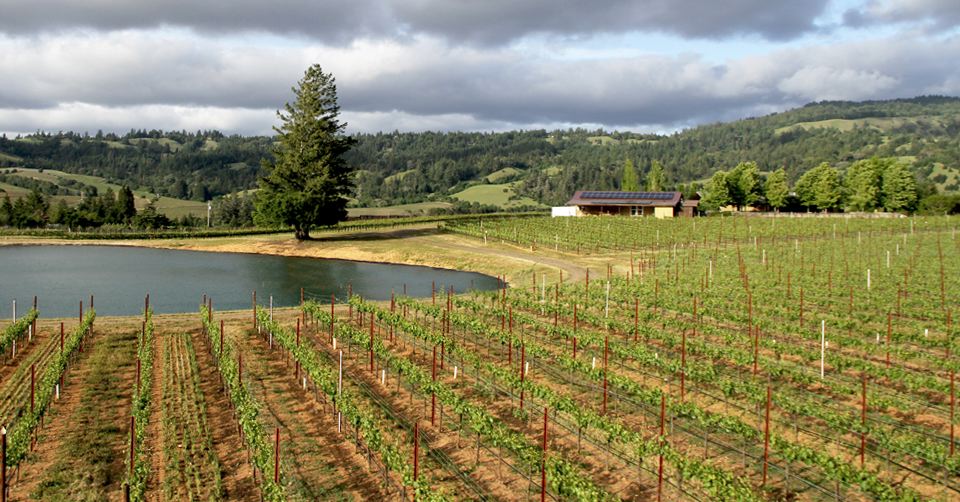 The property was acquired in 2005 and planted to 12 acres (9 clones) of Pinot Noir the following year. It is located in the “deep end” of the Anderson Valley on a plateau that sits 300 feet between the Navarro River and Highway 128. Brian and his wife Cindy operate Angel Camp Vineyard assisted with vineyard management by Tony Sanchez of Ardzrooni Vineyard Management. Angel Camp Vineyard debuted its second vintage, the 2012 Pinot Noir and Pinot Noir Blanc at this year’s Anderson Valley Pinot Noir Festival. The winemaker for the 2011, 2012 and 2013 vintages was Jon Keyes. Phil Baxter became the winemaker in 2014. Grapes are sold to three wineries: Chenamé, Donum Estate/Stemmler and Dutton-Goldfield. The panelists all agreed that site overrides clone and that this site is very special. The cool microclimate is key. Average temperature for Anderson Valley is 64º, Russian River Valley 66º, and Carneros 69º. The three wines were all stellar indicating that this is a vineyard of special promise. 2012 Angel Camp Vineyard Anderson Valley Pinot Noir 13.8% alc., pH 3.46, TA 0.66, 353 cases, $52. Clones 667, Pommard 4, David Bruce, Martini and Swan. Harvest Brix 24.3º. 100% de-stemmed. 4-day cold soak, 17-day fermentation, aged in 40% new French oak. A vibrant wine featuring aromas and flavors of dark stone fruits, dried herbs and an earthy underpinning. Rather elegant and nuanced, with well-managed tannins and a generous finish. 2012 Dutton-Goldfield Angel Camp Vineyard Anderson Valley Pinot Noir 13.8% alc., pH 3.66, TA 0.59, 306 cases, $58. 100% de-stemmed, 5-day cold soak, 21-day co-fermentation of Pommard, “828,” and 667 clones, aged 11 months in 50% new French oak. Explosive aromas of black cherry, black raspberry, spice and sweet oak lead to a medium to full-bodied core of lush and zesty black raspberry and black cherry fruits with hints of cola, Asian 5-spice and dark chocolate. Juicy, with a velvety mouth feel and a supple finish that is remarkably long and focused. 2011 Donum Estate Anderson Valley Pinot Noir 14.3% alc., pH 3.92, TA 0.54, 312 cases, $72. A blend of 115, 667, 777, 2A clones and David Bruce and Swan selections. 1-week cold soak, two fermentations (Dijon and other clones and selections, 50/50). Aged in 54% new French oak barrels. Barrel selection before bottling. Inviting aromas of black cherry, black raspberry, blackberry, root beer, floral bouquet and oak vanillin. Full-bodied and well-structured with deep, dark black berry and black raspberry flavors with a hint of cola. The flavors tiptoe to the edge of ripeness, but fall short of going over the edge. A bit impenetrable and needs more time in bottle.
Postmodern Winemaking: Rethinking The Modern Science Of An Ancient CraftSpeaker Clark Smith, Winemaker and Author
Myself and others at the Conference were impressed by Smith’s grasp of scientific concepts associated with winemaking, his thought-provoking pronouncements and his provocative views. That said, much of his discourse was way beyond the grasp of all but the most knowledgeable wine professional. The book will probably find its biggest audience among winemakers and winemakers-to-be. I did record his talk and plan to post it in the future on my website. If you would like a copy of his presentation, contact Clark Smith through his website at www.winemaking411.com or phone 707-237-7000.
Press Tasting of Anderson Valley Pinot NoirVintage 2011: 2011 was the second cool vintage in a row and was the coldest in the last fifteen years in Anderson Valley. The winter was very wet and the cool spring delayed bud break and flowering, reducing the potential crop. June rain also slowed fruit development. July and August were cool and foggy and precautions had to be taken to prevent mildew. Extra work was necessary in the vineyards involving fruit drops and leaf pulling. Temperatures finally warmed in early September and grapes finally matured. Harvest occurred primarily in October, even late October, and most grapes were harvested before the rains. Vintage 2012: This vintage was a striking contrast to 2011 and has been often referred to as the “Goldilocks” vintage since it was not too not and not too cold. Temperatures rose into the high 80s and even 90s during the summer. Harvest occurred on schedule in mid September to early October before the rains arrived. The perfect conditions helped the grapes reach ideal phenolic ripeness at moderate sugar levels. Unfortunately, the organizers fail to feature wines of the same vintage from each winery, making comparisons and evaluations complicated.
2012 Angel Camp Anderson Valley Pinot Noir 13.8% alc., 353 cases, $55. · Moderate reddish purple color in the glass. Appealing aromas of black cherries, plum and dried herbs. Soft and smooth on the palate with a plethora of dark stone fruits and berries with an earthy undertone. The tannins are integrated and the finish is generous and pleasing. Score: 92
2012 Baxter Langley Vineyard Anderson Valley Pinot Noir 14.5% alc., 125 cases, $48. Roederer clone 23 planted in 1982. Aged in 100% neutral French oak barrels. · Moderately light garnet color in the glass. Very appealing on the nose with true aromas of exotic spice, raspberry and blueberry. Mid weight flavors of blue and black fruits with a silky mouth feel. Still young and a little tight with tannin showing up on the finish. Still, very pure and vibrant and a wine of great potential. Score: 92
2011 Brutocao Slow Lope’n Vineyard Anderson Valley Pinot Noir 13.5% alc., 1,100 cases, $24. Pommard, Swan, 113, 115, 667 and 777. Harvest Brix 23.6º. Aged 18 months in 30% new French oak. · Moderately light reddish purple color in the glass. Shy aromas and flavors of strawberry and cherry with hints of spice, herbs and oak. The tannins are tight and the wine could use some time in the glass. Score: 88
2012 Cakebread Cellars Two Creeks Vineyards Anderson Valley Pinot Noir 14.2% alc., $42. Several Dijon clones, Pommard and Swan selection. Aged 10 months in 38% new French oak. · Moderate reddish purple color in the glass. Very shy aromas of black cherry, raspberry and underbrush. Much more expressive on the palate with vivid black cherry and ripe strawberry flavors complimented by oak. The middleweight fruit core is striking. Score: 90
2011 Champ de Revés Anderson Valley Pinot Noir 14.1% alc., $40. Sourced from Boone Ridge Vineyard above the town of Boonville planted in 2006. Clones 667, 777 and 115. 100% de-stemmed, aged 9 months in 29% new French oak barrels. · Moderate reddish purple color in the glass. An array of aromas including blackberries, blueberries, cut flowers and oak lead to medium to full bodied flavors of ripe purple and black fruits with a tug of toasty oak in the background. The bright acidity lifts the moderately long finish. Score: 89
2012 Drew Balo Vineyard Anderson Valley Pinot Noir 13.5% alc., 142 cases, $45. Harvest Brix 23.4º. 50% Pommard, 35% 115, 15% 777. 20% whole cluster fermentation. · Moderately dark reddish purple color in the glass. Nicely perfumed with aromas of spiced cherry, tea and leaf. Polished on the palate with juicy flavors of red cherry and red berry with a hint of exotic spice. Well-structured with a noticeably generous finish that leaves a lasting impression. Score: 93
2011 Elke Donnelly Creek Vineyard Anderson Valley Pinot Noir 13.5% alc., 196 cases, $36. Release August 2014. 100% de-stemmed, pressed with a basket press, aged 11 months in 35% new French oak. Unfined and unfiltered. · Moderately light reddish purple color in the glass. Appealing scents of red cherry, raspberry and spice. Bright, crisp and vivid red cherry and berry fruits with a deft touch of herbs and oak. Lighter in this vintage but very elegant and charming. Score: 91
2012 Expression Ordway Vineyard Anderson Valley Pinot Noir 14.8% alc., 160 cases, $50. 100% destemmed, 1-week cold soak, short, hot fermentation. Slight extended maceration post fermentation. · Moderately dark reddish purple hue in the glass. Well-ripened cherry and berry aromas. Mid to full bodied core of dark red and black stone fruits and berries with a touch of dark chocolate and cola. Plush and velvety on the palate with refined tannins and a hint of alcohol on the finish. Score: 89
2012 On Point Christina’s Cuvée Anderson Valley Pinot Noir 14.0% alc., 182 cases, $49. Sourced from Donnelly Creek Vineyard. Pommard and Elliot clones. Aged 16 months in 25% new French oak. · Moderate reddish purple color in the glass. Bright aromas of Bing cherry elevate from the glass. Middleweight core of cherry, spice and cola flavors backed by integrated tannins. The finish is very pleasing, lingering with a kiss of cherry. Score: 90
2012 Greenwood Ridge Vineyards Mendocino Ridge Pinot Noir 14.1% alc., 300 cases, $30. Aged 8 months in French oak. · Moderate reddish purple color in the glass. Shy aromas of darker fruits. A forward-drinking wine with discreetly concentrated flavors of black cherry, black raspberry and earthiness. Good lift and harmony with a juicy finish. Score: 90
2010 Handley Cellars RSM Vineyard Anderson Valley Pinot Noir 14.5% alc., 293 cases, $52. Harvest Brix 26.0º. From the 7-acre estate vineyard located 700 to 1,000 feet above the fog line. 3-day cold soak, aged 9 months in 33% new French oak. · Moderately dark reddish purple hue in the glass. Aromas of black cherry, Hoison sauce, dark chocolate, and oak. Mid to full bodied flavors of black fruits, anise, spice and dark chocolate with some oak sheen. Thoroughly satisfying with integrated tannins and a richly fruited finish. Score: 91
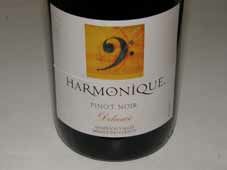 2007 Harmonique Delicacé Anderson Valley Pinot Noir 14.4% alc., 422 cases, $44. Primarily 2A clonefrom Ferrington Vineyard with some 777 clone from Klindt Vineyard and Pommard from Conzelman Vineyards. · Moderately light garnet color in the glass. Welcoming scents of cranberry, strawberry, spice and herbs. Very elegant and light on the palate with a flavorful core of cherry, rhubarb and pomegranate. This wine has aged beautifully and its character definitely fits the name. Score: 90
2010 Husch Knoll Anderson Valley Pinot Noir 14.0% alc., 200 cases, $40. Original plantings that were the first Pinot Noir vines in Anderson Valley dating to late 1960s. Harvest Brix 25.9º-26.4º. 15% whole cluster fermentation. Aged 17 months in 50% new French oak. · Moderate reddish purple color in the glass. A very rustic and earthy wine with aromas of forest floor, mushroom, black cherry and a hint of oak. On the palate, the moderately sappy black cherry fruit is embellished with noticeable oak, very dry tannins and juicy acidity. There is a subtle sense of alcohol. Score: 89
2012 Lichen Estate Anderson Valley Pinot Noir 13.7% alc., 164 cases, $65. From 7 acres of estate vines planted in 2008 and farmed organically. Four clones (Martini, Wädenswil, Pommard and 667) on three rootstocks. First substantial crop. Harvest Brix 22.4º-24.6º. 5 to 6-day cold soak, 2 to 3-day extended maceration. Aged 17 months with batonage during the first 9 months. · Moderately light garnet color in the glass. Demure aromas of red cherry, mocha and sandalwood lead to a very light and elegant, even dilute, palate featuring cherry, raspberry and complimentary oak flavors. This wine has soft tannins and is rather ephemeral, but lacks excitement. Score: 88
NV Lichen Estate Solera Anderson Valley Pinot Noir 13.65% alc., 134 cases, $48. Harvest Brix 22.4º-24.6º. This wine features the “solera” approach common in Sherry to this multi-vintage blend. Combination of first Estate harvest of two barrels in 2011, six barrels of 2012 Estate, and four barrels of 2013 Estate. 5 to 6-day cold soak, 2 to 5-day extended maceration, aged in French oak. · Light rhubarb color in the glass. Scent of oak-kissed cherries and spice echoed on the palate. Light and delicate, but with good flavor intensity, bright acidity, and a finish featuring plenty of cherry and spice goodness. Score: 89
2012 LIOCO Klindt Vineyard Anderson Valley Pinot Noir 12.9% alc., 287 cases, $N/A. Harvest Brix 21º. Clones 115, 667, and 777. Clones co-fermented, 30% whole cluster fermentation, native yeasts, 5-day cold soak. Aged 11 months in 20% new French oak. Unfined and unfiltered. A swan song (vineyard sold and fruit no longer available to LIOCO). · Light garnet color in the glass. Uplifting aromas of fresh cherry, red rose petal, spice and sandalwood. Much more flavorful than color would suggest, with mid weight tastes of dark red cherry and whole cluster spice and floral goodness. The velvety texture is of special interest as is the wine’s remarkable harmony. The class of this tasting. Score: 94
2009 Nelson Hill Anderson Valley Pinot Noir 13.9% alc., 205 cases, $34. Harvest Brix 24.9º. Clones 777, 114, 115 from Deep End Vineyard in Philo. 3-day cold soak, aged 12 months in 50% new French oak. Unfined and unfiltered. · Moderately light reddish purple color in the glass. The aromas and flavors of cherry and pomegranate fruits are offset by an unpleasant vegetal woodiness. Fully mature, with soft tannins. Score: 86
2011 Phillips Hill Two Terroirs C+R Anderson Valley Pinot Noir 13.5% alc., 125 cases, $36. 70% Cerise Vineyard and 30% Ridley Vineyard fruit. Harvest Brix 22º-23º. Whole berry and whole cluster fermentation, 4 to 6-day cold soak, 16 days on skins, natural yeast fermentation. Aged 16 months in 30% new French oak. Unfined and unfiltered. · Moderately light orange-red color in the glass. Light and elegant cherry aromas and flavors with a lively cut of acidity and a heavy tug of oak and oak tannin. Score: 86
2010 Philo Ridge Vineyards Anderson Valley Pinot Noir 13.6% alc., 250 cases, $36. Philo Ridge and Ferrington vineyards. Clones 115, 777, 667, Pommard and Wädenswil. Harvest Brix 23.6º. 100% destemmed, 3-day cold soak, proprietary yeasts, basket bladder pressed, aged 25 months in 35% new French oak and the remainder in neutral barrels. Aged in bottle 6 to 8 months. Unfined and unfiltered. · Moderate reddish purple color in the glass. Highly approachable, with aromas of forest floor, herbs and oak, and an array of red fruits on the lean palate which is accented with spice and acid-driven minerality. Score: 88
2010 Roederer Estate Anderson Valley Pinot Noir 14.4% alc., 300 cases, $40. Estate grown clones 667, 777, 115, Pommard and 114. 100% de-stemmed, aged 10 months in a blend of new and used French oak barrels. Light filtration. · Moderately dark reddish purple color in the glass. Aromas of cherries, dried herbs and oak. Mid to full bodied flavors of black cherry with an herbal thread in the background. The wine displays nicely balanced tannins and acidity, with some finishing intensity and length. Score: 89
2012 Waits-Mast Deer Meadows Vineyard Anderson Valley Pinot Noir 14.0% alc., 97 cases, $55. This vineyard is situated at 1,600 feet elevation above Boonville farmed by Rich Savoy. Harvest Brix 24º-25º. Clones 115, 777 and Calera. 100% de-stemmed, whole berry fermentation, native yeasts. Aged 17 months in 25% new French oak. · Moderate garnet color in the glass. Soaring scents of black cherries, rose petals and spice. Delicious mid to full bodied flavors of dark cherries, dark berries and plums with a riff of Asian 5-spice. The mouthfeel is velvety, the tannins are well proportioned, the oak is beautifully integrated, and the finish has impressive depth and length. Score: 94
2012 Witching Stick Dowser’s Cuvée Anderson Valley Pinot Noir 14.0% alc., 426 cases, $55. A blend of 4 vineyards and several clones from both Anderson Valley and Mendocino Ridge (Akin, Wiley, Cerise and Gianoli vineyards). 77% of fruit from the cooler “deep end” of the valley. Aged 19 months in 27% new French oak. · Medium reddish purple color in the glass. Bright nose with hi-tone scents of dark cherry, dark raspberry, cardamom spice, and oak vanillin. Plenty of ripe cherry and pomegranate fruits and a hint of citrus fill the mouth with layers of pleasure. The wine is still young with some unintegrated tannins, but the potential is evident. Score: 90
Tastings with Winemakers: Drew, Balo, Bink, Knez and Signal Ridge
The MadronesDuring the Anderson Valley Pinot Noir Festival, I had the pleasure of staying at The Madrones, a welcoming, newer, Mediterranean-styled lodging located in Philo on Highway 128. The two-story buildings house four beautifully appointed guest suites. The photo below shows the picturesque view out the window of my suite looking over the vineyard at neighboring Goldeneye. More photos of The Madrones follow.

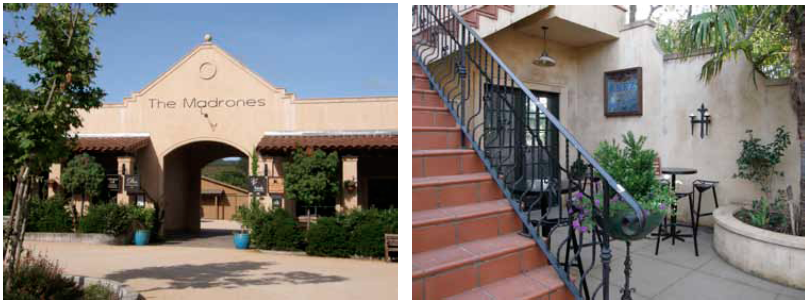
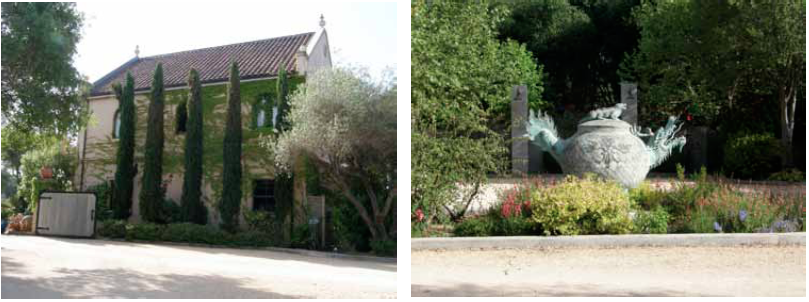 There are four tasting rooms in The Madrones complex including Bink Wines, Drew Family Cellars, Knez Winery and Signal Ridge Vineyards. Balo Vineyards and Domaine Anderson are across the street and Goldeneye is next door. Besides these opportunities to taste wine, the many other winery tasting rooms that dot Highway 128 in the Anderson Valley are only a short drive away.
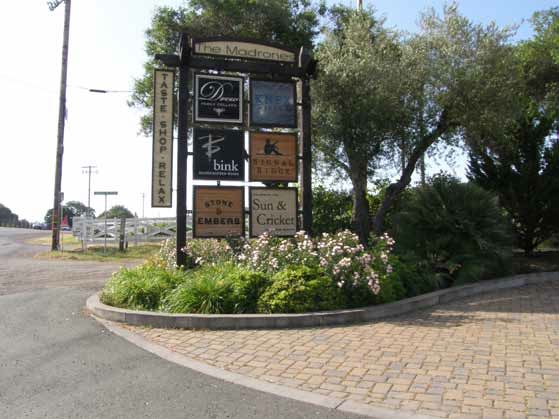 The Anderson Valley has never had any fine dining options other than the Boonville Hotel until the Stone and Embers Restaurant opened in The Madrones. Chef and owner Patrick Meany has an impressive resume, having been the chef du cuisine at Heritage House in Mendocino and stints at Bouchon in Las Vegas and Gary Danko in San Francisco. The restaurant offers lunch on weekends and dinner Monday through Tuesday, with both indoor and outdoor seating. California cuisine is featured including wood-fired pizzas of distinction, including one topped with homemade turducken. If you go, you must try the mushroom ‘chicharrones’ sprinkled with Parmesan. 707-895-3471.
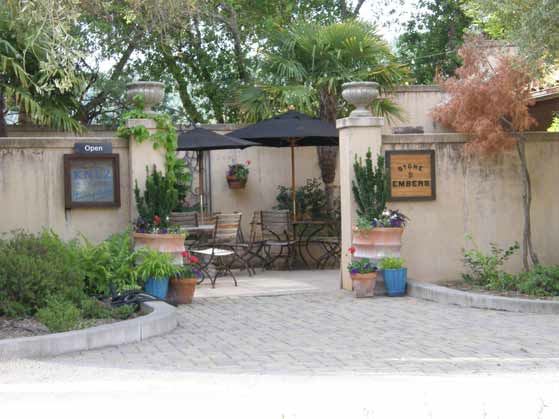 Owner Jim Roberts is often on site, tending the beautiful gardens. He formerly lived on the property but is converting his previous house into additional lodging suites to bring the total to nine. He has spent much of the last twenty years building this delightful oasis in the Anderson Valley. With very few other lodging choices (there are only about 30 rooms in the Anderson Valley), this is a valuable edition to the Anderson Valley community that will surely attract many new wine enthusiasts. For reservations, visit the website at www.TheMadrones.com, or phone 707-895-2955 and tell them “The Prince sent me.”
TastingsDrew Family Cellars - Winemaker Jason Drew It was a treat for me to accompany Jason to Burt Williams’ Morning Dew Ranch in the “deep end” of the Anderson Valley. Since Burt stopped making wine after the 2009 vintage, he has given his favorite blocks to Jason who crafts a superb vineyard-designate Morning Dew Ranch Pinot Noir.
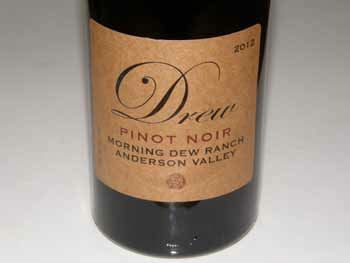 At the Ranch, we met Burt and tasted 2013 barrel samples of Morning Dew Ranch Pinot Noir. One sample was from the Rochioli Block of the vineyard which had more spice and pink flower character. The sample of the “828” Block of the vineyard was more concentrated with slightly darker fruit and more tannin. It was fascinating to walk the vineyard and see two different blocks, observe the soil and aspect differences, and have Drew explain to me how the difference in terroir was translated into the two barrel samples we were tasting.
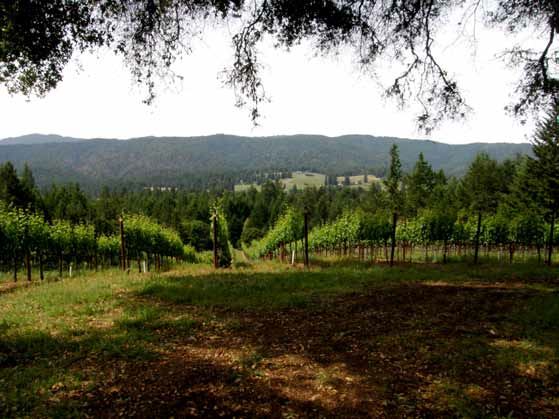 One interesting fact came out of our discussion. I am fascinated by whole cluster fermented wines and Jason is a proponent. He told me that the advantages of whole cluster fermentation include, (1) a longer, slower fermentation, (2) lower finished alcohol, (3) more aromatic interest, and (4) a better mouthfeel. At the Grand Tasting, Drew was offering tastes of his excellent 2013 Mendocino Ridge Vin Gris of Pinot Noir. He crafts a killer Albarino too. Drew wines are sold primarily through a mailing list at www.drewwines.com.
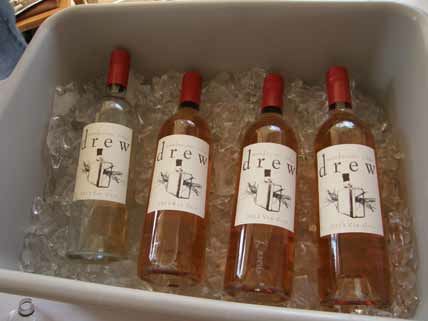
Bink Wines is a partnership between winemaker Deborah Schatzlein and winegrower Cindy Paulson. With degrees in chemistry and biology, Deborah’s expertise in winemaking belies her modest persona. She has a background as a consulting environmental engineer experienced in cleaning up hazardous waste. She developed the water treatment system at The Madrones. Schatzlein started making wine in a garage, then worked at William Hill in the lab and cellar. She became part of the winemaking team at Cliff Lede and took care of their environmental issues as well. A number of classes at University of California at Davis enriched her winemaking knowledge. In 2001, she launched the Bink label and in 2005, became a winemaker full time. The name “Bink” comes from the French for Syrah (“blkink” shortened to “Bink”), and seemed appropriate since she began making dark red wines. Deborah crafts several varietals now, including Sauvignon Blanc, Rosé (Lumineux), Pinot Noir, Merlot, Syrah, and a Red Blend (Melange). The wines are produced across the street at Balo Vineyards facility. The tasting room at The Madrones is open Wednesday through Monday from 11:00 to 5:00, and is staffed by Monika or Bruce. The Bink Wines website is www.binkwines.com. The Pinot Noirs tasted were released the weekend of the Anderson Valley Pinot Noir Festival.
2012 Bink Anderson Valley Pinot Noir 14.5% alc., 190 cases, $40. 100% de-stemmed whole berry native fermentation, aged 16 months in 20% new French oak. · Moderately light reddish purple hue in the glass. An easy drinking, elegant wine featuring cherries, cranberries, vanilla and cinnamon spice. The wine is very forward, with nicely managed tannins, and a pleasingly smooth finish of some length. Score: 90
2012 Bink Thomas T. Thomas Vineyard Anderson Valley Pinot Noir 14.4% alc., 92 cases, $54. Sourced from a 3-acre vineyard planted in 2008 adjacent Toulouse Vineyard. This is a monopole in that Bink takes all the fruit from this vineyard owned by a former Treasurer of Genentech. 4 clones: 777, 115, Calera and Pommard. This wine is 75% Pommard. Aged 16 months in 50% new French oak. A barrel selection. · Moderate reddish purple color in the glass. Plenty to like in this wine with soaring aromas of black cherry and spice echoed on the mid weight palate that offers additional notes of sassafras and cola. Very fresh tasting and impeccably crafted with striking polish and harmony. Score: 92
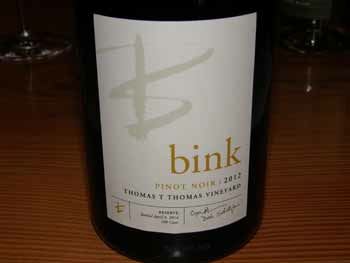
2006 Bink Hawks Butte Vineyard Yorkville Highlands Syrah 14.9% alc., $25. This vineyard is farmed by Cindy Paulson. It is located at 1,800 feet on a steep hillside. Most of the fruit is sold to Wells Guthrie of Copain. 25%-30% whole cluster. · Very dark reddish purple color in the glass. Aromas and flavors of blackberry, cassis, pepper and tobacco. Broad shouldered but refined with an intense, long, fruit-driven finish that leaves a hint of alcohol in its wake. An enjoyable, fully mature wine. Score: 89
Knez Winery - Winemaker Anthony Filiberti Knez Winery is based at Demuth Vineyard, acquired along with Cerise Vineyard by owner Peter Knez in 2007 and 2008. The two vineyards are on the wine grape growing edge, ripening late even by late-ripening Anderson Valley standards. Filiberti was well acquainted with Demuth Vineyard when he joined Knez since he made wine from that vineyard at Anthill Farms. The inaugural Anderson Valley Pinot Noir, a combination of Demuth and Cerise fruit, was released with the 2009 vintage and a 2009 single-vineyard Demuth and Cerise Pinot Noir followed in 2011. Filiberti has moved to the head of the list of respected young California Pinot Noir winemakers. His resume includes working with Lynn Penner-Ash and Josh Bergström in the Willamette Valley, followed by a stint at Williams-Selyem and his continuing work with Anthill Farms. The vineyard manager at Knez is Ryan McAllister who has farmed some of Mendocino’s most prestigious vineyards including Morning Dew Ranch and Hein in Anderson Valley, Weir in Yorkville Highlands and Valenti in Mendocino Ridge. Besides Demuth and Cerise vineyards, McAllister a;so manages the Knez Vineyard that was planted in 2009 and fills the space between Demuth above and Cerise below. As a result, the hillsides adjacent and below the winery site are a contiguous run of vineyard blocks. The vineyard has 4 acres of Pinot Noir, 1 acre of Syrah and Viognier, and 1 acre of Pinot Gris, Friulano and Malavasia. 2012 is the first harvest from Knez Vineyard (pictured below). All Knez Winery vineyards are farmed using organic and Biodynamic practices.
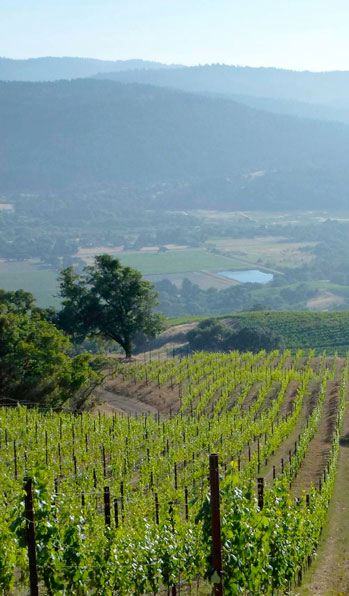 Considerable effort has been expended at the dry-farmed Demuth Vineyard which was planted 30 years ago by the Demuth family. There are 7 acres of Pinot Noir planted to Wädenswil and Pommard clones and 8 acres of Chardonnay entirely planted to old Wente clone. Located at 1,400 to 1,700 feet elevation, the soil is mostly Bear Wallow-Wolfy with a fairly deep topsoil. Compost has been added, the cover crop improved, and yields have been lowered. This vineyard has a smaller diurnal temperature variation (60º-80º) compared to vineyards on the valley floor (50º-90º). Cerise Vineyard has been featured at a previous Anderson Valley Pinot Noir Festival Technical Conference and discussed in detail (www.princeofpinot.com/article/1223/). Soils are primarily Bearwallow with zero to 3 feet of top soil over rocky sandstone. There are 12 different blocks so there is a patchwork of terroir. Because of the wind and poor soils, the vines struggle to be vigorous and produce small clusters and berries. Wines from this vineyard tend to be less forward with more tannins. The Knez tasting room is very relaxing and airy, and it was a pleasure to sit in the cool setting to taste with Filiberti. The tasting room is open Thursday through Monday from 11:00 to 5:00 and is staffed by Filiberti as well as James Wasson and Ryan McAllister. Knez wines are sold through a mailing list with some retail distribution. Visit the website at www.knezwinery.com. The 2012 wines tasted below represent the fourth release from Knez Winery. The first two wines have been released.
2012 Knez Demuth Vineyard Anderson Valley Chardonnay 13.2% alc., 168 cases, $37. Chardonnay vines planted in 1981. Unique small and large berries in same clusters. Harvest first two weeks in October. Native fermentation, 100% malolactic fermentation and aged in 30% new French oak. Bottled 3 weeks before this tasting. · Aromas of lemon, pear and tropical fruits are echoed on the palate which is crisp and bright. Oak plays a complimentary role in the background and the finish is filled with sea brine and electric, lemon-driven acidity. Score: 92
2012 Knez Anderson Valley Pinot Noir 13.5% alc., 1,200 cases, $29. Two-thirds Cerise (primarily Dijon clones), one-third Demuth (primarily Wädenswil). 50% whole cluster fermentation. Aged in 25% new French oak. · Medium reddish purple color in the glass. The nose unfolds nicely over time in the glass to reveal aromas of cherry, raspberry and herbs. Plenty of juicy red cherry fruit shows up on the mid weight palate with a hint of spice. Very silky and sexy in the mouth, with some finishing presence. Score: 89
2012 Knez Demuth Vineyard Anderson Valley Pinot Noir 13.4% alc., 500 cases, $42. 50% Pommard and 50% Wädenswil clones. Harvest Brix 20º-22º. 50% whole cluster, aged in 30% 4-year-air-dried Francois Frères French oak barrels. The barrel management is intended to reduce tannins. · Moderately dark reddish purple color in the glass. Highly perfumed nose with bright aromas of cherries and rose petals with a hint of exotic spices. Very complex flavor profile including cherry, cranberry, dried herbs, and whole cluster spice. More elegant, caressing and accessible than the 2012 Cerise with modest tannins and lasting flavors. Still young, but this is clearly a great wine. Score: 93
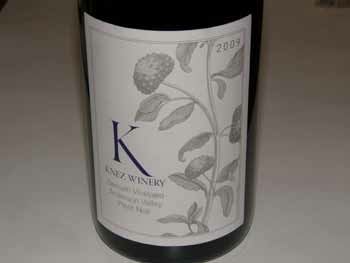
2012 Knez Cerise Vineyard Anderson Valley Pinot Noir 13.6% alc., 650 cases, $42. Clones are primarily Wädenswil, Pommard, Martini and David Bruce. · Dark reddish purple color in the glass. The nose reflects some whole cluster fermentation with aromas of exotic roses, Moroccan spices, black cherries and the slightest oak. A mid weight, brawny wine with big shoulders., offering generous flavors of black cherry, black raspberry, tar and animale. The fruit coats the mouth and provides uncommon intensity on the finish which offers a modest rush of dry tannins. A distinctive wine that is terroir-driven and should improve over the next several years in bottle. Score: 91
2012 Knez Anderson Valley White Wine 13.8% alc., sold out. First crop from Knez Vineyard. Two-thirds Pinot Gris and one-third Malavasia and Friulano. One neutral barrel. · A pleasurable sipping wine that is bright and lively, with flavors of lemon, pear and slightly nutty oak.
Balo Vineyards - Winemaker Jason Drew, Assistant Winemaker Alex Crangle Balo Vineyards is an 8-acre, family owned, organically farmed vineyard in Philo. Originally planted in 1998 by the Mullins family, the vineyard contains five different Pinot Noir clones including 115, 777, “828,” Martini, and Pommard on 101-14 rootstock. The soil profile is a combination of Perry Gulch loam and Boontling loam. Situated on a river bench, the low-vigor soil contains considerable amounts of river rock. The site tends to produce grapes that hold onto acidity. Balo is the Latin word for “bleat,” as in bleating (“baa baa”) of sheep. The early settlers brought sheep with them to the Anderson Valley to provide food and clothing, and the area soon became known for sheep herding and wool production. The Balo estate vineyard is planted on a former sheep pasture. The current winemaker is Jason Drew with Anthony Filiberti taking over in 2015. The tasting room on Highway 128 is open Friday through Monday from 11:00 to 5:00 (dog friendly with an enclosed dog recreation area). The wines are available on the website at www.balovineyards.com. All the following reviewed wines are released.
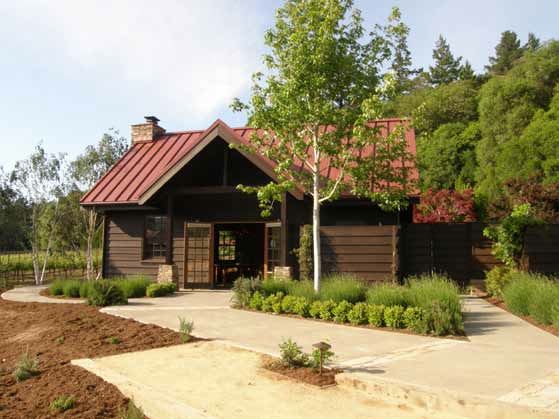
2013 Balo Estate Anderson Valley Pinot Noir Blanc 13.6% alc., pH 3.16, TA 0.72, 45 cases, $28. Clones “828” and 777. Harvest Brix 21.7º. Whole cluster pressed. Vinified in 75% stainless and 25% French oak. · Scents and aromas of pear and strawberry with hints of peach and lemongrass. Bright, with juicy acidity. Score: 88
2012 Balo Anderson Valley Pinot Gris Sourced from Donnelly Creek Vineyard in Boonville. Combination of 50% stainless and 50% neutral oak aging on lees. · Tropical fruit aromas lead to a brisk wine on the palate featuring flavors of pear, tropical fruits, lees and nutty oak. The finish offers uplifting refreshment. Score: 88
2013 Balo Estate Anderson Valley Vin Gris of Pinot Noir 13.4% alc., pH 3.18, TA 0.78, 110 cases, $22. Clones “828” and 777. Harvest Brix 21.2º. Whole cluster pressed. Vinified in 100% stainless steel. · Light pink color in the glass. Delicate but appealing aromas of strawberry jam and cherry. Easy to like for its juicy strawberry fruit flavor accented with a hint of herbs. Finishes very dry and slightly tart. Score: 89
2012 Balo Estate “Suitcase 828” Anderson Valley Pinot Noir 13.6% alc., pH 3.45, TA 0.65, 163 cases, $38. Harvest Brix 23.1º. Upright vines planted in 2003. 30% whole cluster fermentation, aged in 30% new French oak. · Moderate garnet color in the glass. Light to medium weight flavors of cherries, cranberries and raspberries with a spicy accent. Vivid and juicy with electric acidity and a cranberry-driven, soprano finish. Score: 89
2012 Balo Estate Anderson Valley Pinot Noir 13.8% alc., pH 3.35, TA 0.69, 405 cases, $45. Clones are 777, 115, Pommard 5 and Martini. Harvest Brix 23.2º-24.5º. 30% whole cluster fermentation, aged in 30% new French oak. · Moderate reddish purple hue in the glass. Invigorating aromas of black cherry, dark red berry, forest floor and dried herbs. Comforting fullness and velvety on the palate, with a core of modest tannins wrapped in layers of dark cherry and dark red berry fruits and a hint of spice. A complete wine with satisfying mid palate attack, bright underlying acidity, and welcoming finishing acidity. The structure of the wine should carry it for years. Score: 92
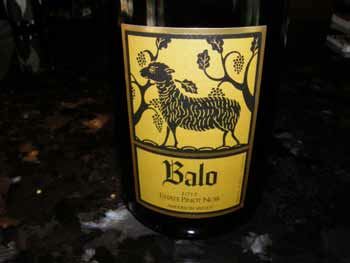
2012 Balo Avenging Angel Anderson Valley Pinot Noir 13.9% alc., pH 3.41, TA 0.62, 152 cases, $55. 50% Balo Vineyard and 50% Angel Camp Vineyard fruit (1 ton of each) produced to remember lost family members and friends. Christian H. Maltby (deceased 9/11/01) and Edward P. Zalanick (deceased 1/3/04) are the inspiration. Clones are Pommard 5, 777, 667, Swan and Wädenswil. Harvest Brix 23.8º. 50% whole cluster. Aged in 15% new French oak. Alex Crangle is the winemaker. · Moderate reddish purple color in the glass. Shy aromas of red fruits, spice and sweet oak. A red cherry bombast that is bracing and very satisfying with a good cut of acidity, a subtle compliment of oak, and a fine-grain, velvety mouthfeel. Everything is in its place in this wine that should age nicely. Score: 92
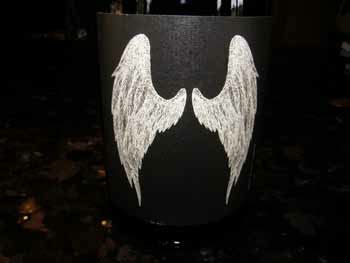 I also tasted some 2013 Pinot Noirs in the cellar out of barrel and these wines are really special. As the amount of whole cluster fermentation increases, the wines are the better for it, since the whole cluster lifts the natural acidity characteristic of Balo Vineyard.
Signal Ridge Vineyard - Winemaker Nicole Scommegna, Assistant Winemaker Stephanie Rivin Roger Scommegna planted a vineyard on top of Cold Spring Mountain in the Mendocino Ridge AVA overlooking Anderson Valley. The steep vineyard (32% slope) sits at an elevation of 2,642 feet, and is the highest altitude vineyard in Mendocino, Sonoma and Napa counties. The winery’s motto is, “What altitude tastes like.” The vineyard is located three ridge lines in from the Pacific Ocean and exposed to maritime influence. Soils are relatively shallow and composed primarily of sandstone, clay and gravelly loam. Yields can be less than 1 ton per acre. Signal Ridge Vineyard is planted in 8 blocks with 6 clones and selections including Pommard, Wädenswil, Swan, 115, 777 and “828.”
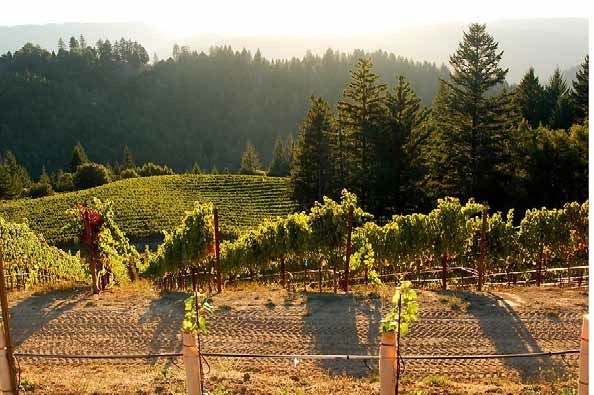 Signal Ridge produces wines from estate and sourced grapes, including Pinot Noir, sparkling wine, Pinot Gris and White Zinfandel under the Signal Ridge label, and Pinot Noir and Zinfandel under the value priced Watchtower label. Grapes are also sold to Bravium wines whose owner and winemaker, Derek Rohlffs produces vineyard-designated Signal Ridge wines at the Dogpatch facility in San Francisco. Bravium will offer 9 bottlings in the 2013 vintage. The Signal Ridge tasting room in The Madrones is open from 11:00 to 5:00 daily. Wines are also available through the website store at www.signalridge.com. The Signal Ridge wines tasted were 2013 barrel samples. All wines had some appeal. The plan is to blend some barrels and bottle a few different blocks separately showing the diversity in the vineyard. This is a fascinating project that I eagerly anticipate will produce unique PInot Noirs.
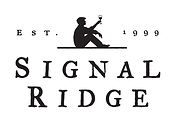 2013 Signal Ridge “828” Clone Mendocino Ridge Pinot Noir 1 new barrel. Good concentration, juicy blackberry and plum fruits with a modest oak sheen. Relatively low acidity. 2013 Signal Ridge Pommard Clone Mendocino Ridge Pinot Noir 1 new barrel, oak fermented. Less concentration, redder fruit, more spice. 2013 Signal Ridge Swan Selection Mendocino Ridge Pinot Noir 1 new barrel. Red fruits, somewhat lean, good acidity, strong tug of oak. 2013 Signal Ridge 777 Clone Mendocino Ridge Pinot Noir 30% whole cluster. 1 three-year-old oak barrel. Aromas of herbs, leaf and tobacco. Impressive concentration, plenty of spice, substantial tannin and a velvety texture. Very appealing. 2013 Signal Ridge 115 Clone Block 7 Mendocino Ridge Pinot Noir No whole cluster. Lovely aromas of dark red cherries and raspberries. Middleweight dark red fruits with integrated fine-grain tannins. 2013 Signal Ridge 115 Mendocino Ridge Pinot Noir No whole cluster. Intense and juicy with a very long finish. 2013 Signal Ridge Block 3 Mendocino Ridge Pinot Noir 30% whole cluster. Soaring aromas of black cherry and spice. A stunning wine that can stand alone with a delicious core of black cherry and black raspberry fruits, well-proportioned tannic backbone and a generous finish.
2012 Bravium Signal Ridge Vineyard Mendocino Ridge Pinot Noir 13.4% alc., pH 3.41, 144 cases, $39. Unreleased. 7 heritage and Dijon clones. 20% whole cluster, native fermentation, aged 19 months in 30% new French oak. Unfined and unfiltered. · Aromas of cranberry, cherry and herbs build in intensity over time in the glass. The mid weight core of dark cherry, red berry, rhubarb and mocha flavors fill the mouth with pleasure. The prominent oak sheen needs time to integrate. The wine finishes with a delightful, acid-driven and cherryimbued finish. Score: 90
Two AV Wineries of Special Mention: Maggy Hawk and Domaine Anderson
Maggy HawkProprietor Barbara Banke (Jackson Family Estates) celebrates Maggy Hawk, a gifted thoroughbred racehorse, with the wines sourced from a 23.55-acre vineyard in the “deep end” of the Anderson Valley. Each wine is named for a horse born to Maggy Hawk, Jolie, Afleet, Stormin’ and Unforgettable, and to her sire, Hawkster. Winegrower Dennis Winchester lives on the property and works with winemaker Elizabeth Grant-Douglas to produces these special wines. The Maggy Hawk label was launched with the 2007 vintage. The Maggy Hawk Vineyard contains a complex of different aspects (primarily south and southeast facing) and clones, producing an array of different Pinot Noirs. It is situated adjacent redwoods at 300 to 530 feet, and is one of the last vineyards in the Anderson Valley before the Pacific Ocean. The soils are decomposed sandstone which has exceptional drainage and low nutrients. Yields are painfully low, never above 2 tons per acre. The vineyard was planted in 2000 to clones 115, 667, Pommard 5 and Wädenswil.
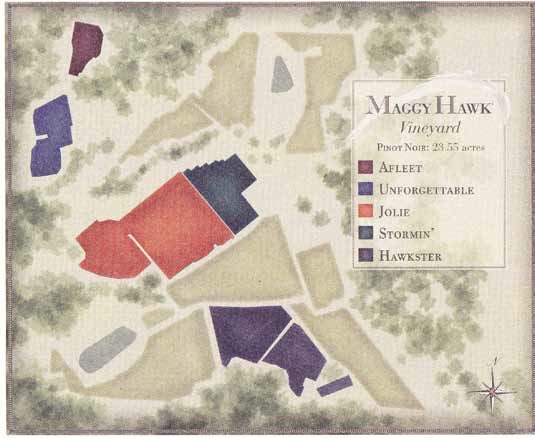 Jolie is from a southeast facing block planted to clone 115 and is always the most nuanced, floral and pretty wine. Afleet is from a 1.23-acre block of Pommard 5 clone and offers complexity, a mouth filling texture, and remarkable consistency. Stormin’ is from clone 667 and shows a powerful nature each year. Unforgettable, also clone 667, but planted on the vineyard’s steepest slope, is difficult to farm and pick, and incredibly low yielding. It is typically dark-fruited, intense and replete with minerality. Hawkster is only produced in the best vintages from Wädenswil clone and is the crown jewel of the Maggy Hawk Collection. I have previously reviewed the 2007 and 2009 vintage wines. They are something special. The wines are sold only through an allocated mailing list at www.maggyhawk.com.
2010 Maggy Hawk Afleet Anderson Valley Pinot Noir 14.5% alc., 147 cases, $55. Pommard clone. · Moderately light garnet color in the glass. Appealing aromas of fresh cherry, wooded forest and pennyroyal. Soft and polished on the palate with a tasty mid weight core of darker cherry and berry fruits with a noticeable overlay of smoky oak. The tannins are suave and very fine. The wine finishes with modest intensity and a little more oak than I prefer, but the charming fruit is enticing. Score: 90
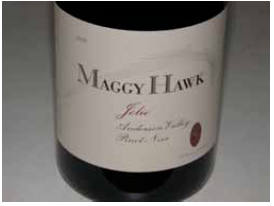 2010 Maggy Hawk Jolie Anderson Valley Pinot Noir 14.5% alc., 291 cases, $55. Clone 115. · Moderately light reddish purple color in the glass. Uplifting aromas of cherry, strawberry, spice and underbrush. Delicious and full in the mouth, with a good attack of dark cherry fruit accented with anise, dark chocolate and toasty oak. Impressive harmony and elegance with complimentary integration of oak. The finish is polished and pleasant. Score: 91
Domaine AndersonDomaine Anderson officially opened during this year’s Anderson Valley Pinot Noir Festival. The winery is the vision of the Rouzaud family of Louis Roederer and their American team dedicated to producing still Pinot Noir and Chardonnay wines. Roederer Estate, which also owns Schraffenberger Cellars, has been in the Anderson Valley for 30 years. Sourced from 52 acres of estate vineyards, the inaugural 2012 vintage of Domaine Anderson produced two estate Pinot Noir and Chardonnay wines from a blend of several vineyards. In addition, two single vineyard Pinot Noir and Chardonnay wines were produced in limited quantities sourced from small, selected blocks in Roederer’s Anderson Valley vineyards. The winery is located south of Roederer Estate Winery in Philo across the street from Goldeneye and adjacent Balo Vineyards. It is surrounded by the 17-acre Dach Vineyard. Domaine Anderson’s winemaker is Jerry Murray, who has dedicated his career to producing super premium Pinot Noir wines. Spanning three continents and eight wineries, Murray acquired his skills working in Oregon, New Zealand and Germany. The winemaker consultant is Jeremy Seysses of Domaine Dujac. The Pinot Noir and Chardonnay wines are aged 16 and 12 months respectively in 25% to 35% new French oak barrels The winery will not be open to the public, but the wines are available through a mailing list at www.domaineanderson.com. The wines are released twice a year to the mailing list.
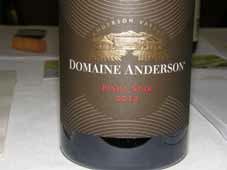 2012 Domaine Anderson Dach Vineyard Anderson Valley Pinot Noir 13.7% alc., $N/A. Inaugural vintage. This 17-acre vineyard is a mile east of the town of Philo at an altitude of 300 feet and surrounds the winery devoted to still Pinot Noir. Aged in about 25% to 33% new French oak for 16 months. · Moderate reddish purple color in the glass. An immature nose featuring a heavy oak presence. Still very young, with mid weight flavors of juicy black cherries, accents of herbs and spice, and generous, firm tannins. Somewhat silky on the palate with a significant oak overlay. Needs to be decanted or time to integrate the oak and tannins. Score: 91
More Sips of Anderson Valley Pinot Noir
2012 Chanamé Angel Camp & Charles Vineyards Anderson Valley Pinot Noir 14.2% alc., pH 3.21, TA 0.57, 49 cases, $45. Harvest Brix 23.5º. 100% de-stemmed, Aged 14 months in Sonoma Mountain caves in 50% new French oak. Unfined and unfiltered. · Moderate reddish purple color in the glass. Shy, but appealing aromas of cherry pie glaze and red raspberry preserves. Vivid flavors of cherry, cranberry and raspberry with a hint of spice and sandalwood. Very juicy, with bright acidity and immersed tannins, building in the mouth to a climatic finish. An impressive wine that has an uplifting freshness and impeccable balance. Even better the following day flaunting a glorious and vibrant cherry presence. Score: 93
2011 Foursight “Zero New Oak” Charles Vineyard Anderson Valley Pinot Noir 13.5% alc., pH 3.73, TA 0.58, 121 cases, $38. Released May 2014. 2011 was the coldest vintage since Charles Vineyard was planted. Clones 777, 115, 114 and Pommard 5. Aged in second-year and older barrels. 10% whole clusters, wild yeast and wild ML cultures. Unfined and unfiltered. · Light garnet color in the glass. Aromas of red cherries and berries with a hint of briar and herbs. Soft and smooth on the palate, somewhat delicate, and quite enjoyable for its fresh red cherry and berry fruits encased in polished tannins. A fruity, easy to enjoy wine that features the purity of unplugged Pinot Noir fruit. Score: 89
2011 Foursight Charles Vineyard Anderson Valley Pinot Noir 13.7% alc., pH 3.71, TA 0.58, 121 cases, $. Released May 2014.Crafted from all four clones in the vineyard: 777, 115, 114 and Pommard 5. 10% whole clusters, native yeast and native ML cultures. Aged in 40% new and 60% three+-year-old French oak barrels. Unracked, unfined, unfiltered. · Light garnet color in the glass. More flamboyant on the nose with aromas of black cherries, spice and sweet oak. A very lovely wine that is seductively polished and seamless, featuring a plethora of sweet cherry goodness accented with spicy oak. Score: 90
2011 Foursight Clone 05 Charles Vineyard Anderson Valley Pinot Noir 14.2% alc., pH 3.71, TA 0.59, 125 cases, $49. Released October 2013. 100% Pommard clone 05. 10% whole clusters, wild yeast and wild ML cultures. Aged in 66% new and 34% 3-year-old and older French oak barrels. · Moderately light reddish purple color in the glass. A penetrating nose flush with aromas of black pie cherries, dried herbs, brewed tea and toasty oak. Very flavorful, with impressive fullness and plushness on the palate, featuring flavors of dark red cherry and berry with a touch of cola. Soft and silky with a cherry-driven finish embellished with a deft touch of oak. I have said it many times, Pommard is my paramour. Score: 92
2011 Goldeneye Anderson Valley Pinot Noir 14.5% alc., 12,626 cases, $55. 90% of grapes are from estate vineyards with the remainder from vineyards in the warmer, southernmost part of the valley. 4 vineyards, 19 clones. Aged 16 months in 70% new French oak barrels. · Moderately light reddish purple color in the glass. The aromas of black cherry, raspberry, exotic spice and toasty oak leap out of the glass. Mid to full bodied core of well-ripened dark cherry and berry fruits with a hint of spice and a modest oak sheen. Forward and friendly, with modest tannins and some finishing intensity. Score: 90
2011 Goldeneye Gowan Creek Vineyard Estate Grown Anderson Valley Pinot Noir 14.5% alc., 927 cases, $80. 8 clones grown on several rootstocks. Wild pennyroyal grows at Gowan Creek and can often be tasted in the wine. · Moderate reddish purple color in the glass. Shy, but pleasant aromas of dark raspberry, dark strawberry and oak. A little more structured, more intensely flavored and displaying a more generous finish than the Anderson Valley bottling, with tastes of dark berries, dark chocolate and cola complimented by well integrated oak. Needs time to open in the glass and will benefit from further cellaring, but hard to resist now. Score: 92
2011 Goldeneye Confluence Vineyard Estate Grown Anderson Valley Pinot Noir 14.5% alc., 303 cases, $80. Dijon and Pommard clones and heritage selections. · Moderate reddish purple color in the glass. Very aromatic, with waves of dark berry, crushed plum, rose petal and sweet oak aromas. Full-bodied flavors of cherry pie, dark berry jam, and toasty oak. Tremendous concentration of fruit sap but held in check by a healthy tannin structure. Excellent oak management. Finishes very long with a flourish of ripe black cherry fruit. A robust wine that is rich and luscious. Score: 93
2011 Goldeneye Ten Degrees Estate Grown Anderson Valley Pinot Noir 14.5% alc., 579 cases, $115. Drawn from the best blocks and barrels from estate vineyards, it is made up of the top 1.5% of estate grown Pinot Noir. The wine is a result of more than 50 trial blends of wines from Gowan Creek, Confluence and Split Rail vineyards (96 blocks and 49 combinations of clones and rootstocks). · Moderate reddish purple color in the glass. Lovely aromas of black cherry, black raspberry, sweet oak and rose petal build in intensity over time in the glass. Juicy and bright on the palate, with a special energy and vibe, featuring an array of berry and stone fruits complimented by oak. This wine has the structure and balance to age ten years and beyond. A connoisseur’s wine of uncommon grace and composition that easily justifies its lofty price. Score: 94
2012 La Crema Anderson Valley Pinot Noir 14.4% alc., pH 3.80, TA 0.52, 2,014 cases, $50. Sourced primarily from Maggy Hawk Estate Vineyard. Wädenswil, Pommard, 115, 777 and 667 clones.100% destemmed, 70% whole berries in tank, 5-day cold soak, fermented in open tanks, aged 9 months in 38% new French oak. · Moderate reddish purple color in the glass. Restrained, but pleasant aromas of black cherry, rose petal and seasoned oak. Mid to full bodied core of fresh black cherry fruit that is generous on the palate and finishes with good intensity. The tannins are balanced and the mouthfeel is silky. Straightforward and fruit-driven, but hard to ignore. Better over time in the glass which is always a good sign. Score: 90
2012 Navarro Anderson Valley Pinot Noir 14.2% alc., $19.50. · Moderately light reddish purple color in the glass. Vibrant aromas of Bing cherry and raspberry lead to a mid weight, pleasurable wine featuring flavors of black cherry, black raspberry and plum with a hint of anise and spice. Plenty of sap to satisfy, with impressive finishing intensity and length. A forward drinking wine with good balance that has an impressive finish for a value priced offering. Score: 90
2012 Navarro Méthode Á L’Ancienne Anderson Valley Pinot Noir 14.1% alc., $29. · Medium reddish purple color in the glass. The nose is reserved initially, opening nicely over time in the glass to reveal scents of red cherry, herb garden and floral goodness. More polished and less ripe fruit flavored than the Anderson Valley bottling. The cherry fruit really stands out in this mid weight wine with additional accents of raspberry and baking spices. Very sleek and refined and quite forward. Does not have the fruit-filled finish of the Anderson Valley bottling, but is a more high-collared, sophisticated offering. Score: 92
2012 Navarro Deep End Blend Anderson Valley Pinot Noir 14.3% alc., $49. Sourced from Middle Ridge, Marking Corral, Garden Spot and South Hill vineyards. · Moderate reddish purple color in the glass. The nose is both exotic and fruity, offering scents of dark cherries, black raspberries and redwood forest. A beautiful wine in all respects with plenty of spicy black cherry and black raspberry fruit supported by integrated fine-grain tannins, and an intensely fruited finish. This wine has a special texture which is hard to describe, but stands out from the other two 2012 Pinot Noir bottlings from Navarro. So juicy and tasty, you can “nibble” at it. Score: 94
2012 Stemmler Anderson Valley Pinot Noir 14.1% alc., pH 3.90, TA 0.57, 117 cases, $44. Released May 2014. Inaugural release from the Angel Camp Vineyard in the “deep end” of the Anderson Valley. Dijon clones “828,” 115, 667 and 777 plus Pommard and Wädenswil clones, and David Bruce, Swan, and Martini selections. Indigenous yeast fermentations. Aged 15 months in 20% new Remond French oak barrels. · Moderately dark reddish purple color in the glass. The richly fruited nose explodes with aromas of dark berries and cherries and the wondrous smell of wine cave. Very suave and seductive on the palate, with waves of dark berry and plum fruit balanced with refined tannins. Packs plenty of pleasure, although not as appealing the following day from a previously opened and re-corked bottle indicating it is a wine for current drinking. Score: 90
2012 Twomey Anderson Valley Pinot Noir 14.1% alc., $46. Released May 1, 2014. Sourced from Monument Tree Vineyard and Ferrington Vineyard. Aged 11 months sur lie in 50% new French oak. · Moderate reddish purple color in the glass. Aromas of raspberry coulis, cherry, blackberry, dark chocolate and oak are echoed on the mid weight palate. Pleasant and solid, with good balance and some finish, but nothing stands out. Score: 89
2012 WALT Blue Jay Anderson Valley Pinot Noir 14.9% alc., 3,688 cases, $40. Sourced from Anderson Creek (a warmer site) and Savoy ( a cool site in the “deep end”) vineyards. Native yeast fermentation, aged in 40% new French oak. Unfined and unfiltered. · Moderate reddish purple hue in the glass. Very shy nose becoming somewhat more aromatic over time in the glass to reveal scents of black cherry, violets and spice. Light to mid weight flavors of blueberries and black raspberries. Soft tannins, straightforward, and easy to drink with a complimentary touch of oak in the background. Score: 88
2012 WALT The Corners Anderson Valley Pinot Noir 15.2% alc., 473 cases, $65. Dijon 667 sourced from Anderson Creek and Annahala vineyards in the Boonville region in the southeastern corner of the Anderson Valley AVA. Native yeast fermentation, aged in 45% new French oak. Unfined and unfiltered. · Moderately dark reddish purple color in the glass. Brooding dark fruits on the nose lead to middleweight flavors of black fruits and tarry oak. The fruit is buried in muscular tannins and the wine finishes hot. A rather simple, fruit-driven wine that is undistinguished. Score: 86
2012 WALT Savoy Vineyard Anderson Valley Pinot Noir 14.5% alc., 414 cases, $65. Native yeast fermentation, aged in 50% new French oak. Unfined and unfiltered. · Dark reddish purple color in the glass. A full-bodied wine featuring an array of dark fruits including blackberries and plums with a prominent oak presence. Very seamless, with integrated tannins, and seems to slip off the palate like silk. A high brow wine that can age, but appealing now. Score: 89
2010 Woodenhead Wiley Vineyard Anderson Valley Pinot Noir 14.5% alc., pH 3.61, TA 0.55, 296 cases, $60. 28-year-old vines (Pommard 5 and Romanee-Conti 37). Unfined and unfiltered. This wine really caught my attention at the Grand Tasting at the Anderson Valley Pinot Noir Festival. · Moderately dark reddish purple color in the glass. Definitely some pennyroyal on the nose with added scents of blackberries, tea, and spice. Very dark fruited, this wine is flush with black raspberry, black cherry and black tea notes that envelope the palate. The dreamy tannins offer a fine-grain texture and the oak hits all the right notes. This wine has the stuffing to age beautifully, but is very hard to resist now. A magnificent wine from one of Anderson Valley’s most esteemed vineyards. Score: 94
Other Anderson Valley Pinot Noir wines reviewed previously in 2014 in the PinotFile:
2011 Black Kite Cellars River Turn Anderson Valley Pinot Noir
Pinot BriefsMalibu Coast Receives AVA Status 52 winegrowers became classified as part of the official Malibu Coast American Viticultural Area in July. Elliott Dolin, proprietor of Dolin Malibu Estate Vineyards, helped to initiate the 3-year process. Few people are aware that the wine grape growing history in the Malibu area goes back two centuries. The region is about 46 miles long and 8 miles wide, composed mainly of the Santa Monica Mountains with 198 acres of vines in production. Elevations range from sea level to 3,111 feet a top Sandstone Peak. The coastal, Mediterranean climate heavily influences the region, offering a large diurnal shift from day to night, with warm, dry summers and cool, moist winters. The most widely planted varieties are Cabernet Sauvignon, Syrah, Merlot and Chardonnay with a smattering of Pinot Noir. The Malibu Coast AVA is also home to two previously established AVAs, Saddle Rock Malibu and Malibu-Newton Canyon.
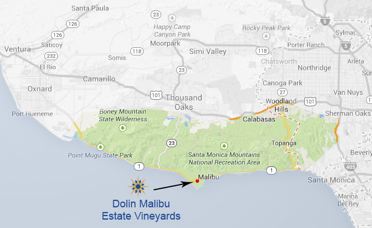 WineGlass for iOS Uses iPhone to Rate Wines on Wine List WineGlass is an app that allows you to take a photo of the wine menu with the iPhone camera and WineGlass then scans the wine list, pulls up the individual wines using the Cellar Tracker database containing over 4 million tasting notes, and reveals wine reviews, tasting notes, food pairings, and expected price. The app was developed by Facebook veteran Roddy Lindsay and works on most wine menus. WineGlass for iOS is available for $4.99 from www.itunes.apple.com.
 Chehalem Mountain Winegrowers Origin ’14 A food and wine event set in the vineyard at Arbor Brook Vineyards, Saturday, August 9, 2014, 4:30 to 8:00 PM. This is a chance to meet the characters behind the 27 participating wineries, walk among vines and vineyard blocks, and feast on food from Bamboo Sushi, The Bent Brick, Cha Cha Cha, The Painted Lady and Subterra. $60 per person. For tickets, visit www.chehalemmountains.org. Shipping Wine in Summertime is a Challenge This time of year it is so warm in parts of the country, such as Orange County, California, where I live, it is impractical to ship wine unless it is transported by refrigerated carrier (FedEx and UPS offer this in California) or shipped overnight (not always a guarantee that the wine will be delivered the following day). If wine is exposed to heat, it undergoes rapid oxidation and spoilage. I have met with several damaged bottles already this summer. ACH Foam Technologies’ WineLoc® is a shipping method that guarantees a shipment is protected at or below 80ºF for 72 hours (this concerns me as 80ºF is pretty hot for wine, particularly if it remains at this temperature for 2 to 3 days. The company’s summer wine shippers keep the wine inside at a constant stable temperature for approximately 72 hours. 2-, 6-, and 12-pack EPS foam units are contained within an outer corrugated box and use specially designed pockets that hold frozen gel refrigerants that allow internal airflow while protect the wine labels from damage during transit. The shipping containers are the first EPS packaging made of 60% or more recycled content. I have not received a wine shipment using this technology. Visit summerwhieshipper@achfoam.com. New Documentary ‘A Year in Champagne’ The second move in the series (the first was ‘A Year in Burgundy,’) has been acquired by Samuel Goldwyn Films, the distributor that turned the film ‘SOMM’ into a sensation. Writer and director David Kennard’s followup movie boasts many revelations about Champagne. The star of both films is Martine Saunier, who acts as a guide, leading a rare glimpse behind the scenes into six Champagne houses including Gosset and Bollinger. The movie has already screened to audiences at the Santa Barbara and Palm Beach International Film Festivals and the documentary is scheduled for an early spring 2015 release.
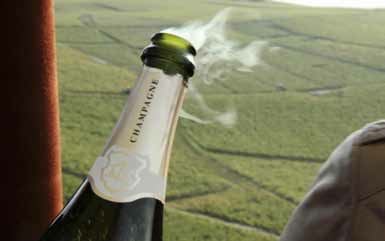 Plot to Poison the World’s Greatest Wine Revealed in New Book Journalist Maximillan Potter wrote this book in cooperation with Domaine Romanee-Conti’s owner Aubert de Villaine. It details the failed attempt to ransom the DRC estate by poisoning its vines. Titled, Shadows in the Vineyard: The True Story of a Plot to Poison the World’s Greatest Wine,” the book relates how Jacques Soltys poisoned two vines with herbicide in an attempt to extort money from the estate before he was caught in a police sting operation. Soltys committed suicide while awaiting trial. Potter also delves into the history of the domaine, the history of wine fraud, and property ownership in Burgundy.
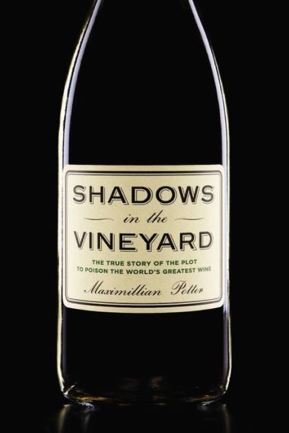 2014 Wine Blog Awards I was one of the judges, that along with the public, votes on the annual Wine Blog Awards. The winners were awarded at the recent Wine Bloggers Conference in Santa Barbara County. Highlights: Best Industry/Business Wine Blog - Tom Wark’s Fermentation: The Daily Wine Blog; Best Wine Reviews on a Wine Blog - Wine School of Philadelphia; Best Winery Blog - The Lynmar Life; Best Writing on a Wine Blog: HoseMaster of Wine; Best New Wine Blog - Girl and the Grape; and Best Overall Wine Blog - Jamie Goode’s Wine Blog. An Analysis of Wine Critic Consensus The Journal of Wine Economics, published by the American Association of Wine Economists (AAWE), recently released AAWE Working Paper No. 160: “An Analysis of Wine Critic Consensus: A Study of Washington and California Wines” (Eric T. Stuen, Jon R. Miller and Robert W. Stone). The research looked at the degree of consensus in quality ratings among prominent wine publications including Wine Spectator, Wine Enthusiast, Wine Advocate, and International Wine Cellar. The authors found ample critical consensus between the four publications. Consensus was not found to be related to the blinding policies (or lack thereof) of the critical publications. The findings, which involved matched ratings of 401 wines, showed that quality ratings have a substantial degree of objectivity to them. |